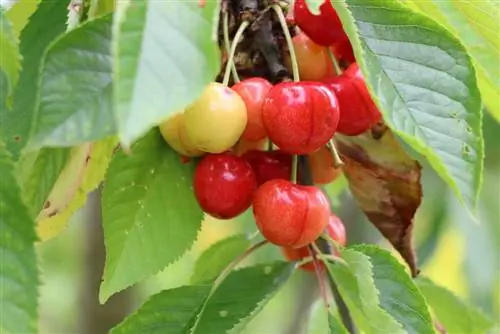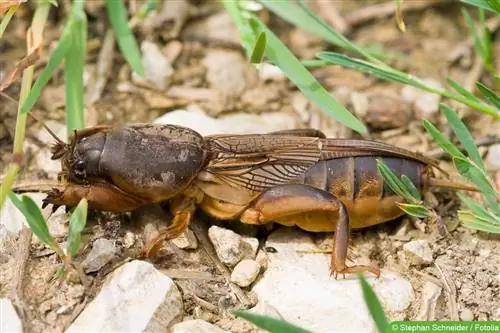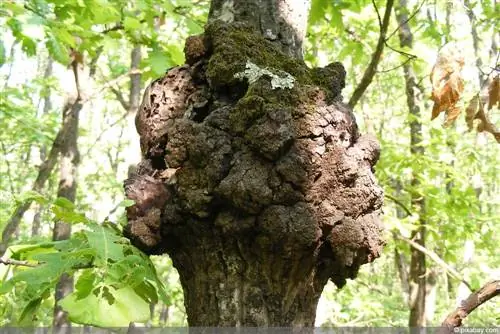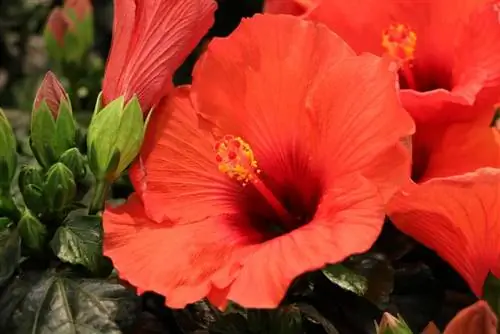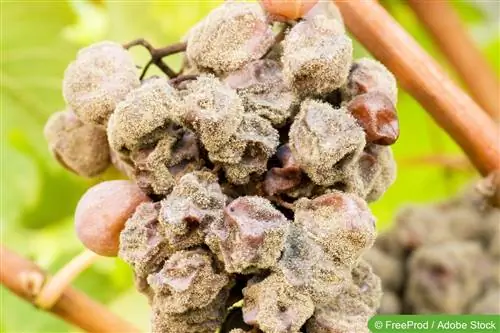- Author admin [email protected].
- Public 2023-12-17 03:39.
- Last modified 2025-01-24 12:45.
The black cherry aphid is a voracious insect that can cause severe damage to the cherry tree. Due to its small size, this parasite is often overlooked and can spread quickly. When combating these pests, natural antidotes are preferable so that the cherries are not contaminated by toxic substances. If the aphids are prevented from spreading in time, the tree and the harvest can still be saved.
Cherry aphid
The dark lice are not particularly large and are therefore often overlooked. In addition, the voracious parasites are mistakenly confused with small beetles, a mistake that can have fatal consequences. These special aphids are divided into two types, the sweet cherry aphid and the sour cherry aphid. Both pests spend the winter as eggs on the cherry tree and hatch just in time for the buds to burst. As a rule, a large part of the cherry aphid population migrates to other plants in the summer and then returns to the cherry tree in the fall to lay their eggs there.
- Black eggs are laid on the shoots in winter
- Hatch from March to April
- Suck the leaves immediately
- Cherry aphid is spherical and only 2 mm long
- Both pest species attack both sweet and sour cherries
- Differences are characterized by the resulting harmful images
- Colonies are usually found on the underside of the leaves
malicious image
Since lice can cause great damage, the cherry aphid must be combated to protect fruit trees. A colony of parasites is often only noticed when it is already too late and clear damage to the cherry tree and its leaves can already be seen. The infestation can be seen with the naked eye if you look closely. Not only does the damage to the cherry tree make it look unsightly, it also weakens it extremely. This can lead to a loss of flowering and the subsequent harvest. If the infestation remains untreated, it can have even more extreme consequences for the entire tree.
- Sour cherry aphid causes compression of the shoots
- This causes the leaves to curve slightly
- Sweet cherry aphid causes major damage
- Leaves curl extremely at the tips when infected
- Lice can cause the tree to die
- The formation of honeydew is typical
- The honeydew causes additional damage to the tree
- This makes cherries inedible
Fight
To combat lice, there are certain effective methods that can be used to sustainably reduce the infestation or even eliminate it completely. To ward off this plague, tried and tested home remedies are particularly suitable. In contrast to chemical alternatives, these are significantly he althier and far more environmentally friendly. Many of the home remedies are already available in most kitchen cupboards. A perfect approach is that you can remove the pests from the leaves immediately and specifically. A lye made from conventional soap, which can be prepared quickly, is suitable for this purpose. The soapy water produced forms a greasy film on the leaves and ensures that the lice can no longer hold on. This also prevents the pests from breathing.
- Water off lice directly with a sharply focused jet of water
- Spray especially under the leaves
- Repeat method more often
- Simply cut off shoot tips that are already severely damaged
- Dispose of these in household waste far away
- 50 g core or soft soap with 50 ml spirit and 1 liter water
- Mix the ingredients well until the soap has dissolved in the water
- Spray the affected tree generously with it
- Repeat a few times, a few days apart
Tip:
Aphids must always be disposed of professionally, otherwise the parasites can spread again from the place of disposal in the respective garden. That's why a compost heap is not a good place for it, nor is the nearby garbage can.
Stinging nettle broth
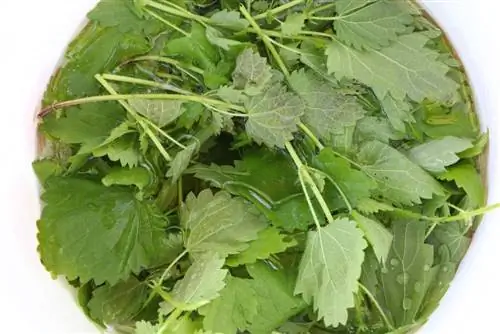
Stinging nettle broth is mainly used as a fertilizer in local gardens, but this product has also proven to be very useful against pests. The broth ensures that the leaves become significantly harder over the course of the treatment so that they can no longer be eaten by the lice. However, the tree must be sprayed in its entirety with the nettle broth. If only individual and easily accessible leaves are sprayed, the parasites pass directly to the untreated leaves. Making this antidote is very simple, but it takes a while and requires some patience.
- Mix 1 kg of nettles with about 10 liters of water
- Both dried and fresh nettle leaves are suitable
- Soak the leaves in water for a few days
- Stir well every now and then
- When no more bubbles appear, the brew is ready
Garlic stock
Garlic is a popular ingredient in many dishes and is used in most households. The tubers have an intense smell and distinctive taste, which repels pests. Garlic also has a disinfecting and cleansing effect. The garlic broth sustainably strengthens the tree's resistance and also fights unwanted parasites. The preparation of the home remedy is simple and quick to implement.
- Roughly chop 2-3 cloves of garlic
- Fill medium-sized pot with one liter of water
- Let garlic pieces cook for a few minutes
- Then filter out pieces from the brew
- Spray the affected tree holistically with the garlic decoction
- Repeat treatment several times
Neem oil
Neem oil is an organic, yet very powerful remedy against parasites. The oil originally comes from Asia and has long been established there as a potent home remedy against pests. Therefore, the aphids can be removed with this without any problems. However, pure neem oil is very strict, so it must be diluted before use.
- Mix 5 ml of neem oil with 1 liter of water
- Spray the tree over a large area with it
- Repeat treatment after a few days
- Never spray oil directly onto the plant substrate
Prevention
To prevent an infestation, the cherry trees should be observed very carefully and cared for carefully. The earlier the colony with the parasites is discovered, the more effectively it can be prevented. By using natural predators, cherry aphid infestation in the garden can be sustainably prevented. To achieve this, it should be designed as close to nature as possible in order to offer insects and birds suitable habitats. A large variety of plants in the garden, with various mixed cultures, is very helpful. In addition, fertilizer doses also play an important role in aphid infestation, as the choice of fertilizer can definitely promote these pests.
- Examine shoots and leaves regularly
- Start from bud break
- Trees are particularly at risk during the flowering period
- Attract predators through fly boxes, insect hotels and dead wood corners
- Provide breeding places and retreats for birds
- It is better to avoid excessive fertilizer applications with nitrogen

